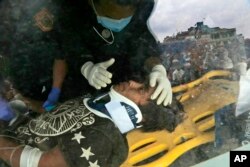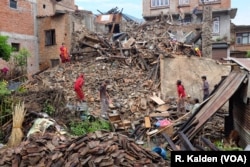One week after a devastating 7.8-magnitude earthquake struck Nepal, officials said Saturday that hope of finding survivors was fading.
Two days after any signs of life had been detected among the mountains of rubble that litter the capital, Kathmandu, Laxmi Dhakal of Nepal's Home Ministry said, "Unless they were caught in an air pocket, there is not much possibility."
Two survivors were rescued from the rubble Thursday.
Nepal officials said Saturday that the death toll had passed 7,000, the Associated Press reported. Most of the deaths occurred in and around Kathmandu.
Survivors are urging the government and aid groups to move faster to get food, water and other assistance to the many people living in the open after losing their homes.
In Kathmandu, some signs of normalcy have returned as merchants conducted business and some residents packed up tents and moved indoors. Still, the overwhelming smell of dead bodies has become a main reason many residents have not returned to their homes.
U.N. humanitarian affairs chief Valerie Amos visited devastated areas in Nepal on Friday as part of her three-day visit to assess relief operations. She told reporters that emergency funding for relief efforts was streaming into the country and urged the international community to increase its support.
Nepal's government is giving $1,000 to the families of the dead plus $400 for burial costs.
The United Nations said more than 8 million people had been affected by the earthquake and at least 2 million had been displaced.
The International Committee of the Red Cross has created a website for friends and family to report missing loved ones or search for those who have checked in.
Survivors found
The rescue of the two survivors Thursday provided rare moments of joy in the grisly recovery process.
Cheers rang out as rescuers pulled Pemba Tamang, a 15-year-old boy, from a demolished guest house. Hours later, a hotel kitchen worker, Krishna Devi Khadka, also was pulled to safety.
The youth, caked in dust, suffered only minor cuts and bruises. The boy said he stayed alive by eating a jar of ghee — clarified butter — that he found in the darkness of the debris he was trapped in.
Rescue workers said Khadka was conscious and talking after being found, with one saying, "It is as though she had been born again."
Major losses
VOA correspondent Steve Herman visited the village of Majigaon, northeast of Kathmandu, where he said people are dealing with the destruction of every building, along with the major loss of their livestock. He said they also are not getting much outside help.
"There has been scant and fleeting presence in this part of the country," he said. "We were told that a team of about five Singaporeans stopped by yesterday to give first aid. They were here for less than 20 minutes, and that has been it so far here in this particular village on the banks of the Indrawati River."
Authorities are also trying to assess the quake's destruction at many of Nepal's ancient historical sites. Christian Manhart, UNESCO representative to Nepal, said at least three of Kathmandu's seven World Heritage sites were "very, very heavily destroyed."
But Manhart told VOA he was optimistic many of the centuries-old sites could be restored.
"I have some hope that restoration can be very successful, because in the rubble we have all the architectural features. So what cracked down is mainly the brick walls. And the statues and the wooden beams, which are very beautifully carved in most of these temples, all of them are there," he said.
Manhart estimated that it could take more than 10 years to restore the World Heritage sites.














